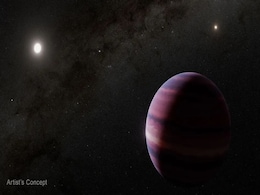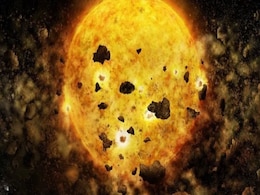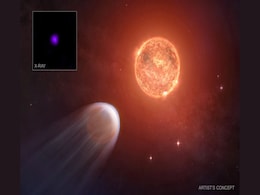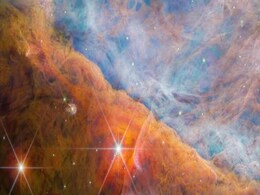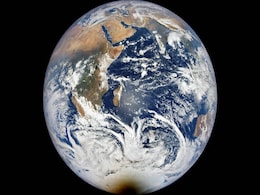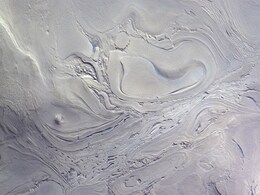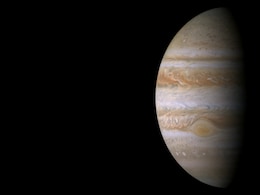Gas Giants Orbiting
- All
- News
-

James Webb Telescope Detects Potential Gas Giant Exoplanet Just 4 Light-Years Away
- Friday August 8, 2025
- Written by Gadgets 360 Staff
Astronomers using JWST have spotted a possible gas giant orbiting Alpha Centauri A, only 4 light-years away. If confirmed, it would be the closest exoplanet to a Sun-like star ever imaged. The discovery could challenge current models of planetary formation in binary systems and open new opportunities for studying nearby worlds.
-
 www.gadgets360.com
www.gadgets360.com
-

Doomed Exoplanet TOI-2109b Spirals Toward Its Star with Three Possible Fates
- Monday July 28, 2025
- Written by Gadgets 360 Staff
The gas giant TOI-2109b, over five times Jupiter’s mass, is spiraling closer to its star in a rare planetary death spiral. With a 16-hour orbit and blistering heat, the exoplanet could either plunge into its host star, be torn apart by tidal forces, or evolve into a rocky super-Earth through photoevaporation. NASA’s TESS and ESA’s Cheops data...
-
 www.gadgets360.com
www.gadgets360.com
-

Young Exoplanet Spotted Shedding Atmosphere Under Stellar Radiation
- Thursday July 17, 2025
- Written by Gadgets 360 Staff
NASA’s Chandra X-ray Observatory and Hubble Space Telescope have captured a dramatic cosmic event: a baby exoplanet, TOI 1227 b, is being stripped of its atmosphere by powerful X-rays from its host star. Only 8 million years old and orbiting a red dwarf, this Jupiter-sized planet is losing gas at a rate equal to Earth’s entire atmosphere every ...
-
 www.gadgets360.com
www.gadgets360.com
-

Discovery Of Small Star Giving Birth To Huge Planet Leaves Scientists Puzzled
- Friday June 6, 2025
- Science | Edited by Srishti Singh Sisodia
TOI-6894 is roughly 240 light-years from Earth in the constellation Leo and is the smallest-known star to host a large planet.
-
 www.ndtv.com
www.ndtv.com
-

JWST Discovers Jupiter-Mass Binary Objects in Orion Nebula, Offering New Clues
- Friday December 13, 2024
- Written by Gadgets 360 Staff
The James Webb Space Telescope has identified dozens of Jupiter-mass binary objects (JuMBOs) in the Orion Nebula. These enigmatic rogue gas giant pairs orbit each other at distances of 25 to 400 AU. Researchers propose they could be failed stars formed under extreme radiation conditions, ejected planetary systems, or a mix of both. Simulations repl...
-
 www.gadgets360.com
www.gadgets360.com
-

Youngest Exoplanet Ever Discovered Orbiting Around a Growing Protostar 520 Light-Years Away
- Friday November 29, 2024
- Written by Gadgets 360 Staff
TIDYE-1b, a "baby" gas giant exoplanet just 3 million years old, has been discovered orbiting a protostar in the Taurus molecular cloud. The planet’s youth makes it around 1,500 times younger than Earth, offering a rare glimpse into planetary formation. However, TIDYE-1b is orbiting a star surrounded by a misaligned protoplanetary disk, which cha...
-
 www.gadgets360.com
www.gadgets360.com
-

Massive Planet As Light And Fluffy As Cotton Candy Puzzles Scientists
- Wednesday May 15, 2024
- Science | Edited by Amit Chaturvedi
The researchers also determined that the gas giant orbits its star, similar in size to our Sun, once every 6.2 days.
-
 www.ndtv.com
www.ndtv.com
-

What Will Happen To Our Solar System When Sun Dies? Study Explains
- Wednesday February 7, 2024
- Science | Edited by Amit Chaturvedi
The study mentions the exoplanets orbiting two different white dwarf stars named WD 1202-232 and WD 2105-82 at distances of 34 and 53 light-years from Earth, respectively. They are believed to be between 1 and 7 times the mass of Jupiter.
-
 www.ndtv.com
www.ndtv.com
-

"Fluffiest Planet Ever": Scientists Discover "Marshmallow World" In Deep Space
- Monday October 24, 2022
- World News | Edited by Bhavya Sukheja
Scientists are finding all sorts of weird worlds. They've now discovered a gas giant planet with the density of a marshmallow orbiting a cool red dwarf star located 580 light years from Earth. The planet, identified as TOI-3757 b, is the "fluffiest".
-
 www.ndtv.com
www.ndtv.com
-

NASA's James Webb Telescope Detects Water On Distant Planet. Details Here
- Wednesday July 13, 2022
- Science | Press Trust of India
NASA's James Webb Space Telescope has detected signs of water, along with evidence for clouds and haze, in the atmosphere of a hot, puffy gas giant planet orbiting a Sun-like star over a thousand light years away, the US space agency said today.
-
 www.ndtv.com
www.ndtv.com
-

NASA Confirms Existence of More Than 5,000 Exoplanets Beyond Our Solar System
- Tuesday March 22, 2022
- Edited by Gadgets 360 Newsdesk
NASA has said that these exoplanets include small, rocky worlds like Earth and “super Earths” which are larger than our own. There are also gas giants several larger than Jupiter and “mini-Neptunes.” Some of these planets orbit two stars at once and others stubbornly revolve around the collapsed remnants of dead stars.
-
 www.gadgets360.com
www.gadgets360.com
-

Is That a Giant Tree Stump on Mars? This Image From the Red Planet Is Not What It Seems
- Tuesday February 1, 2022
- Edited by Gadgets 360 Newsdesk
Recent photos of the Red Planet show large concentric rings on the surface. These rings look very similar to a tree stump's rings. But that's not the case. The European Space Agency (ESA) released a photo and explained the image through a statement on their website. The image is actually a bird's eye view of an ice-rich impact crater on the surface...
-
 www.gadgets360.com
www.gadgets360.com
-

ESA Shares Photo Of One of The Biggest Impact Basins On Martian Surface
- Saturday November 6, 2021
- Edited by Gadgets 360 Newsdesk
The European Space Agency (ESA) has shared stunning images of one of the biggest impact basins in the Solar System, located on Mars. Hellas, with a diameter of 1,430 miles (2,300km) and a depth of over 4.3 miles (7km), is believed to have formed between 3.8 billion and 4.1 billion years ago after a large asteroid hit the surface of Mars.
-
 www.gadgets360.com
www.gadgets360.com
-

NASA's Juno Probe to Fly Over Jupiter's Great Red Spot Today
- Tuesday July 11, 2017
- Agence France-Presse
Juno, which earlier this month marked its first year in orbit of the gas giant, will offer "humanity's first up-close and personal view of the gigantic feature."
-
 www.gadgets360.com
www.gadgets360.com
-

James Webb Telescope Detects Potential Gas Giant Exoplanet Just 4 Light-Years Away
- Friday August 8, 2025
- Written by Gadgets 360 Staff
Astronomers using JWST have spotted a possible gas giant orbiting Alpha Centauri A, only 4 light-years away. If confirmed, it would be the closest exoplanet to a Sun-like star ever imaged. The discovery could challenge current models of planetary formation in binary systems and open new opportunities for studying nearby worlds.
-
 www.gadgets360.com
www.gadgets360.com
-

Doomed Exoplanet TOI-2109b Spirals Toward Its Star with Three Possible Fates
- Monday July 28, 2025
- Written by Gadgets 360 Staff
The gas giant TOI-2109b, over five times Jupiter’s mass, is spiraling closer to its star in a rare planetary death spiral. With a 16-hour orbit and blistering heat, the exoplanet could either plunge into its host star, be torn apart by tidal forces, or evolve into a rocky super-Earth through photoevaporation. NASA’s TESS and ESA’s Cheops data...
-
 www.gadgets360.com
www.gadgets360.com
-

Young Exoplanet Spotted Shedding Atmosphere Under Stellar Radiation
- Thursday July 17, 2025
- Written by Gadgets 360 Staff
NASA’s Chandra X-ray Observatory and Hubble Space Telescope have captured a dramatic cosmic event: a baby exoplanet, TOI 1227 b, is being stripped of its atmosphere by powerful X-rays from its host star. Only 8 million years old and orbiting a red dwarf, this Jupiter-sized planet is losing gas at a rate equal to Earth’s entire atmosphere every ...
-
 www.gadgets360.com
www.gadgets360.com
-

Discovery Of Small Star Giving Birth To Huge Planet Leaves Scientists Puzzled
- Friday June 6, 2025
- Science | Edited by Srishti Singh Sisodia
TOI-6894 is roughly 240 light-years from Earth in the constellation Leo and is the smallest-known star to host a large planet.
-
 www.ndtv.com
www.ndtv.com
-

JWST Discovers Jupiter-Mass Binary Objects in Orion Nebula, Offering New Clues
- Friday December 13, 2024
- Written by Gadgets 360 Staff
The James Webb Space Telescope has identified dozens of Jupiter-mass binary objects (JuMBOs) in the Orion Nebula. These enigmatic rogue gas giant pairs orbit each other at distances of 25 to 400 AU. Researchers propose they could be failed stars formed under extreme radiation conditions, ejected planetary systems, or a mix of both. Simulations repl...
-
 www.gadgets360.com
www.gadgets360.com
-

Youngest Exoplanet Ever Discovered Orbiting Around a Growing Protostar 520 Light-Years Away
- Friday November 29, 2024
- Written by Gadgets 360 Staff
TIDYE-1b, a "baby" gas giant exoplanet just 3 million years old, has been discovered orbiting a protostar in the Taurus molecular cloud. The planet’s youth makes it around 1,500 times younger than Earth, offering a rare glimpse into planetary formation. However, TIDYE-1b is orbiting a star surrounded by a misaligned protoplanetary disk, which cha...
-
 www.gadgets360.com
www.gadgets360.com
-

Massive Planet As Light And Fluffy As Cotton Candy Puzzles Scientists
- Wednesday May 15, 2024
- Science | Edited by Amit Chaturvedi
The researchers also determined that the gas giant orbits its star, similar in size to our Sun, once every 6.2 days.
-
 www.ndtv.com
www.ndtv.com
-

What Will Happen To Our Solar System When Sun Dies? Study Explains
- Wednesday February 7, 2024
- Science | Edited by Amit Chaturvedi
The study mentions the exoplanets orbiting two different white dwarf stars named WD 1202-232 and WD 2105-82 at distances of 34 and 53 light-years from Earth, respectively. They are believed to be between 1 and 7 times the mass of Jupiter.
-
 www.ndtv.com
www.ndtv.com
-

"Fluffiest Planet Ever": Scientists Discover "Marshmallow World" In Deep Space
- Monday October 24, 2022
- World News | Edited by Bhavya Sukheja
Scientists are finding all sorts of weird worlds. They've now discovered a gas giant planet with the density of a marshmallow orbiting a cool red dwarf star located 580 light years from Earth. The planet, identified as TOI-3757 b, is the "fluffiest".
-
 www.ndtv.com
www.ndtv.com
-

NASA's James Webb Telescope Detects Water On Distant Planet. Details Here
- Wednesday July 13, 2022
- Science | Press Trust of India
NASA's James Webb Space Telescope has detected signs of water, along with evidence for clouds and haze, in the atmosphere of a hot, puffy gas giant planet orbiting a Sun-like star over a thousand light years away, the US space agency said today.
-
 www.ndtv.com
www.ndtv.com
-

NASA Confirms Existence of More Than 5,000 Exoplanets Beyond Our Solar System
- Tuesday March 22, 2022
- Edited by Gadgets 360 Newsdesk
NASA has said that these exoplanets include small, rocky worlds like Earth and “super Earths” which are larger than our own. There are also gas giants several larger than Jupiter and “mini-Neptunes.” Some of these planets orbit two stars at once and others stubbornly revolve around the collapsed remnants of dead stars.
-
 www.gadgets360.com
www.gadgets360.com
-

Is That a Giant Tree Stump on Mars? This Image From the Red Planet Is Not What It Seems
- Tuesday February 1, 2022
- Edited by Gadgets 360 Newsdesk
Recent photos of the Red Planet show large concentric rings on the surface. These rings look very similar to a tree stump's rings. But that's not the case. The European Space Agency (ESA) released a photo and explained the image through a statement on their website. The image is actually a bird's eye view of an ice-rich impact crater on the surface...
-
 www.gadgets360.com
www.gadgets360.com
-

ESA Shares Photo Of One of The Biggest Impact Basins On Martian Surface
- Saturday November 6, 2021
- Edited by Gadgets 360 Newsdesk
The European Space Agency (ESA) has shared stunning images of one of the biggest impact basins in the Solar System, located on Mars. Hellas, with a diameter of 1,430 miles (2,300km) and a depth of over 4.3 miles (7km), is believed to have formed between 3.8 billion and 4.1 billion years ago after a large asteroid hit the surface of Mars.
-
 www.gadgets360.com
www.gadgets360.com
-

NASA's Juno Probe to Fly Over Jupiter's Great Red Spot Today
- Tuesday July 11, 2017
- Agence France-Presse
Juno, which earlier this month marked its first year in orbit of the gas giant, will offer "humanity's first up-close and personal view of the gigantic feature."
-
 www.gadgets360.com
www.gadgets360.com

